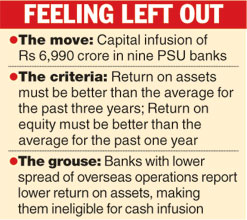IASbaba's Daily Current Affairs Analysis, IASbaba's Daily Current Affairs August 2015, National, UPSC
Archives
IASbaba’s Daily Current Affairs- 13th August, 2015
NATIONAL
Higher education sector in India : An analysis
- India’s higher education system is the third largest in the world, next to the United Statesand China and it is likely to surpass the US in the next five years and China in the next 15 years to be the largest system of higher education in the world.
- Higher education in India has recorded impressive growth since Independence. As of 2011, India has 42 central universities, 275 state universities, 130 deemed universities, 90 private universities, 5 institutions established and functioning under the State Act, and 33 Institutes of National Importance.
- University Grants Commission (UGC), by designing programmes and implementing various schemes through academic, administrative and financial support, has contributed in the growth and development of Indian higher education.
Critical analysis of higher education sector in India:
- The gross enrolment into higher education has remained at about 20% over the years. We have only 722 universities, as against the National Knowledge Commission recommendation of 1,500.
- Another challenge that confronts India is in the disparities in access to education, especially in terms of economic class, gender, caste and ethnic and religious belonging.
In 2008, as against an all-India enrolment rate of 17 per cent, the break-up for these categories was 7 per cent for Scheduled Tribes (ST), 11 per cent for Scheduled Castes (SC), 28 per cent for Other Backward Classes (OBC) and 47 per cent for higher castes. In addition, it was 9 per cent for Muslims, 18 per cent for Hindus and 30 per cent for Christians.
- Between 1996 and 2008, private institutions expanded every year at the rate of 10 per cent. The corresponding decline in government and private-aided institutions, by 1.65 per cent yearly, resulted in increase in the share of students in the private institutions.
- The quality of higher education is an equally serious problem in higher education sector in India.
According to Industry reports supported by NASSCOM, only 25% of technical graduates and about 15% of other graduates are considered employable by IT/ITES industry due to lack of basic skills required for the job.
- Apart from these, there is the issue of ensuring the access of Indian education to global frontiers. In this, a popular view is to allow global universities to set up campuses in India.
- Enabling an education that is relevant to the economy and society is another challenge.
- Another issue relates to reform in the University Grants Commission(UGC) w.r.t its structure and functioning.
Yashpal committee recommendations on reforms in higher education sector:
- All universities must be teaching cum research universities. All research bodies must connect with universities in their vicinity and create teaching opportunities for their researchers.
- There should be no discrimination between Central and State funded universities. All benefits extended to Central Universities must also be extended by State Governments to the state universities and the Centre must incentivise the States to do so.
- All private universities must submit to a national accreditation system. Private degree-granting universities must not be confined to select areas like technology, medicine, management, finance etc. They must be required to be comprehensive universities covering the arts and social and natural sciences too.
- There must be tight regulation of private universities in terms of auditing of accounts, payment of minimum salaries to teachers, certain percentage of seats reserved for meritorious students who are to be provided scholarships etc.
- Granting of Deemed University status to be put on hold. All existing Deemed Universities to be given three years to shape up (to have strong research programmes, and become a comprehensive university as defined in this report) failing which their Deemed University status is to be withdrawn.
- National tests like the GRE must be organised round the year to get admissions into universities. Students from all over India must be allowed to take the tests as many times as they like and their best score can be sent to the universities for admission.
- Setting up National Commission for Higher Education and Research (NCHER) under which the various functions of the existing regulatory agencies would be subsumed and it becomes an apex regulating agency of the higher education sector.
Connecting the dots:
- Examine the issues associated with higher education sector in India ? Suggest measures to overcome the same.
- Implementation of Yashpal committee report acts as a game changer in higher education sector of India. Critically analyse.
- Enrolment ratio in higher education is only 20% in India .At this backdrop critically analyse preparedness of India in reaping Demographic Dividend.
ECONOMICS
Capital infusion in public sector banks
- In the past 15 years, the Government has infused more than Rs.81, 000 crore
 capitals in PSU banks but this capital is eroding due to rising bad assets.
capitals in PSU banks but this capital is eroding due to rising bad assets. - With non-performing assets of public sector banks (PSBs) soaring of late (as of the January-March quarter, gross NPAs stood at 5.20 per cent compared with 5.63 per cent in December), the Finance Ministry has announced that it will infuse Rs.70,000 crore over the next four years.
- The capital infusion will be done in three tranches – Rs 25,000 crore in this fiscal and the next followed by Rs 10,000 crore each in 2017-18 and 2018-19.
What are Non-Performing Assets (NPA’s)?
- Non-performing assets, also called non-performing loans, are loans,made by a bank or finance company, on which repayments or interest payments are not being made on time.
- A loan is an asset for a bank as the interest payments and the repayment of the principal create a stream of cash flows.
- It is from the interest payments than a bank makes its profits.
What is Capital Infusion?
- When one division is not doing well, it might benefit from an infusion of new funds from the more successful divisions.
- In the context of venture capital, it can also refer to funds received from a venture capitalist to either get the firm started or to save it from failing due to lack of cash.
How does Capital Infusion boost economy?
- Adding Capital to banks is to enable them to lend to borrowers in selected sectors such as two wheelers, consumer durable, etc, at lower rates in order to stimulate demand.
- Capital Infusion will lower the cost of lending to banks under the Marginal Standing Facility Window (MSF) to improve liquidity in the system.
- More capital to PSU banks will lower the borrowing cost and increase their capacity to lend, besides promoting investments.
Is the Rocky Road ahead for PSB’s?
- PSB executives feel that the thrust on efficiency is welcome but the timing was questionable.
- For, most state-owned banks face challenges due to big asset quality pressures, large scale retirement and a leadership gap at the top.
- Capital raising efforts by PSBs other than the capital infusion by the government, face challenges because of their relatively low equity valuations compared to their private sector peers.
What does the Moody’s Report Says?
According to the Moody’s Investors Service
- The government’s plan to recapitalise public sector undertaking (PSU) banks to the tune of Rs.70, 000 crore over four years is ‘credit positive, but not a game changer’.
- Although the capital infusion plan is credit positive, we note that the capital amount is a fraction of the overall capital requirements over the next four years.
- Moody’s report does credit the government with changing the previous policy of providing capital to only select banks.
Connecting the Dots:
- “Though the capital infusion plan is credit positive, banks still need access to equity markets to materially improve their capital levels”. Explain.
- Is the money through Capital Infusion enough to take care of the capital needs, and, if it is not, how easy or difficult will it be for the public sector banks to raise money from the markets?












